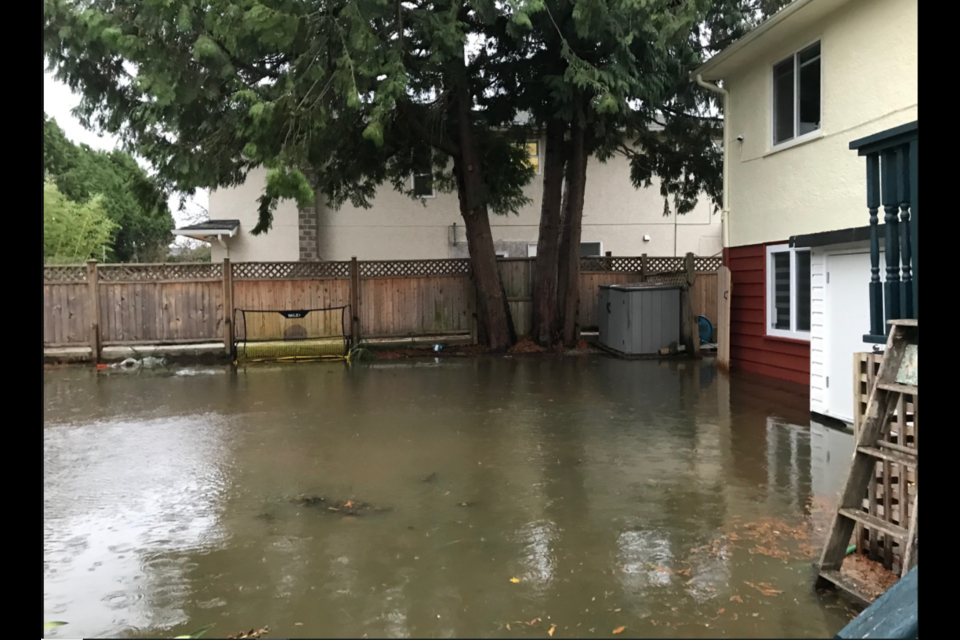A Richmond family whose home was flooded with feces and filthy water after a sewer pipe burst during last month’s flooding says neither their insurance company nor Metro Vancouver will help them out.
Hazra Imran said it seems like “no one cares” about the appalling situation the family now finds themselves in.
The entire lower floor, carport and backyard of the house were damaged by water on Nov. 15 – leaving the family-of-four without access to their kitchen, living area and laundry, said Imran, adding repairs are estimated to cost $200,000.
Imran said sewer water began flooding into their home around 8:30 a.m. that day, caused by a burst sewer pipe at the intersection of Gilbert and Blundell roads.
At the time, Metro Vancouver told the Richmond News the “sanitary failure” was caused by the extreme rainfall.
The family – who moved into their home less than two years ago and renovated in just the past year – has now been living upstairs for nearly a month, trying to keep things as normal as possible for their 11 and 13-year-old children.
Unable to use their kitchen due to the damage caused by the dirty sewer water, Imran said she has been cooking using an instant pot and going out to buy meals and bottled water regularly.
“We renovated this place – it’s not even one year old, so everything is new. And, seriously, I don’t want to use it because it was sewage water, so it was contaminated water.”
Since the flooding, Imran and her husband, Imran Akhtar, have been trying to get help from either their insurance company or Metro Vancouver – only to be told it isn’t their problem.
In the denial letter sent to Imran and her husband – a copy of which was viewed by the Richmond News – Intact Insurance Company states their policy doesn’t cover certain water damage and sewer backups.
“No one (from the insurance company) even came here. They just sent the denial letter,” said Imran.
In an email to the News, Intact said it offers an “enhanced water damage protection package,” but apparently Imran and Akhtar didn’t have that additional coverage.
In its own compensation denial letter, Metro Vancouver stated that it “cannot be held liable in nuisance for damages arising out of the breakdown or malfunction of a sewer system.”
The regional body also advised Imran and her husband to reach out to their insurance company again.
“So that’s what’s happening – everyone is shifting blame to the other party,” she said.
“I don’t even know if they are even considering that there is a family here who is in this kind of distress.”
In an email to the News, Metro Vancouver reiterated that the issue is between the family and their insurance company.
Imran said she also applied to DFA about three weeks ago – the province’s disaster financial assistance – but has yet to hear back.
The family is now trying to fix their house by themselves, which means removing parts of the walls and taking out furniture and cabinets.
“Whatever we are touching, it’s like we are opening up a can of worms, because then it’s so many things that need to be done.”
But the Richmond family is far from alone in their plight, said Rob de Pruis, western and pacific director of consumer and industry relations for the Insurance Bureau of Canada.
Thousands of claims have been submitted, and the insurance industry is expected to pay out $415 million. However, the standard home insurance policy doesn’t cover damage as a result of sewer backups or overland flood damages, explained de Pruis.
These are separate, optional endorsements people can add on to their coverage. But in some areas that are high risk – such as the areas impacted by the recent flooding – that optional coverage is either very limited or not available as the costs would be unaffordable for residents.
“Insurance is about risk, and the higher risk some of these areas are, for the flood risk, it’s very difficult and in some cases impossible to obtain insurance coverage. So for this event, the costs will largely be born by taxpayers and the government through their disaster financial assistance,” de Pruis said.
He noted one challenge is that there’s no publicly available flood mapping, which could help people understand what properties are at high risk.
There’s also the question of coming up with a solution to the challenges faced in high risk areas – which could include looking at how infrastructure and properties in these areas are rebuilt.
In regards to insurance, the federal government announced a task force on flood insurance and relocation in November 2020 – IBC is a member of one of the subcommittees, de Pruis said – to create a low-cost residential flood insurance program to protect residents in high risk areas.
“It’s not an easy answer, because there’s not enough money to be paying out all the damages. You wouldn’t be able to collect enough premiums. There has to be some type of an initial, public-private partnership to help develop this pool,” according to de Pruis.
He said the task force is currently reviewing options and is expected to give direction on what to explore further in spring 2022.
de Pruis also noted that many of those impacted by the flooding were also impacted by the wildfires earlier this year – and the COVID-19 pandemic is still ongoing.
“So that emotional toll on the families and in these communities is just something that’s absolutely tragic, and something that we really need to pay attention to,” he said.
That includes calling on government and stakeholders to work together to develop prepared and resilient communities that can face current and future weather realities.



